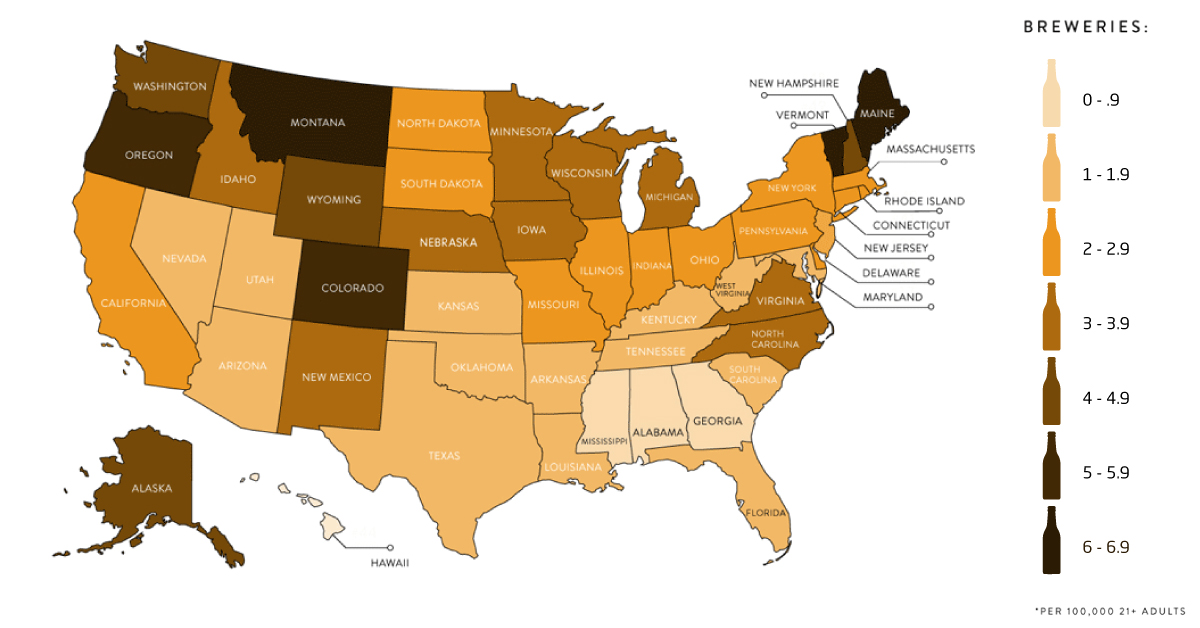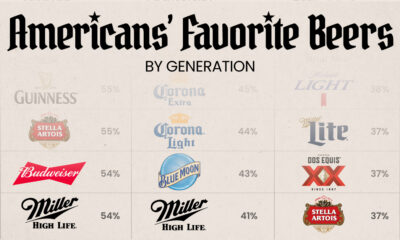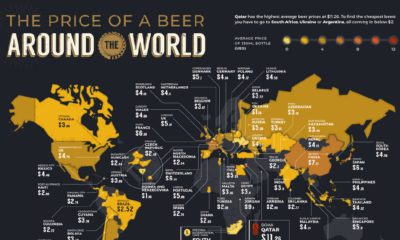Markets
Craft Beer Boom: The Numbers Behind the Industry’s Explosive Growth
All movements start with rebellion, and the craft beer revolution is no different.
Born from the frustration of mass-produced beer made from cheap ingredients, entrepreneurs went head-to-head with global brewery giants to showcase local and independent craftsmanship.
Suddenly, drinking beer became less about the alcoholic content and more about the quality and experience. Craft beer allowed for constantly changing flavors, recipes, and stories. With sales accounting for 24% of U.S. beer market worth over $114 billion, the global craft beer movement has been historic.
Which States Bring Home the Beer?
Today’s map from C+R research demonstrates the growth of the craft beer market, by ranking the U.S. states based on craft breweries per capita.
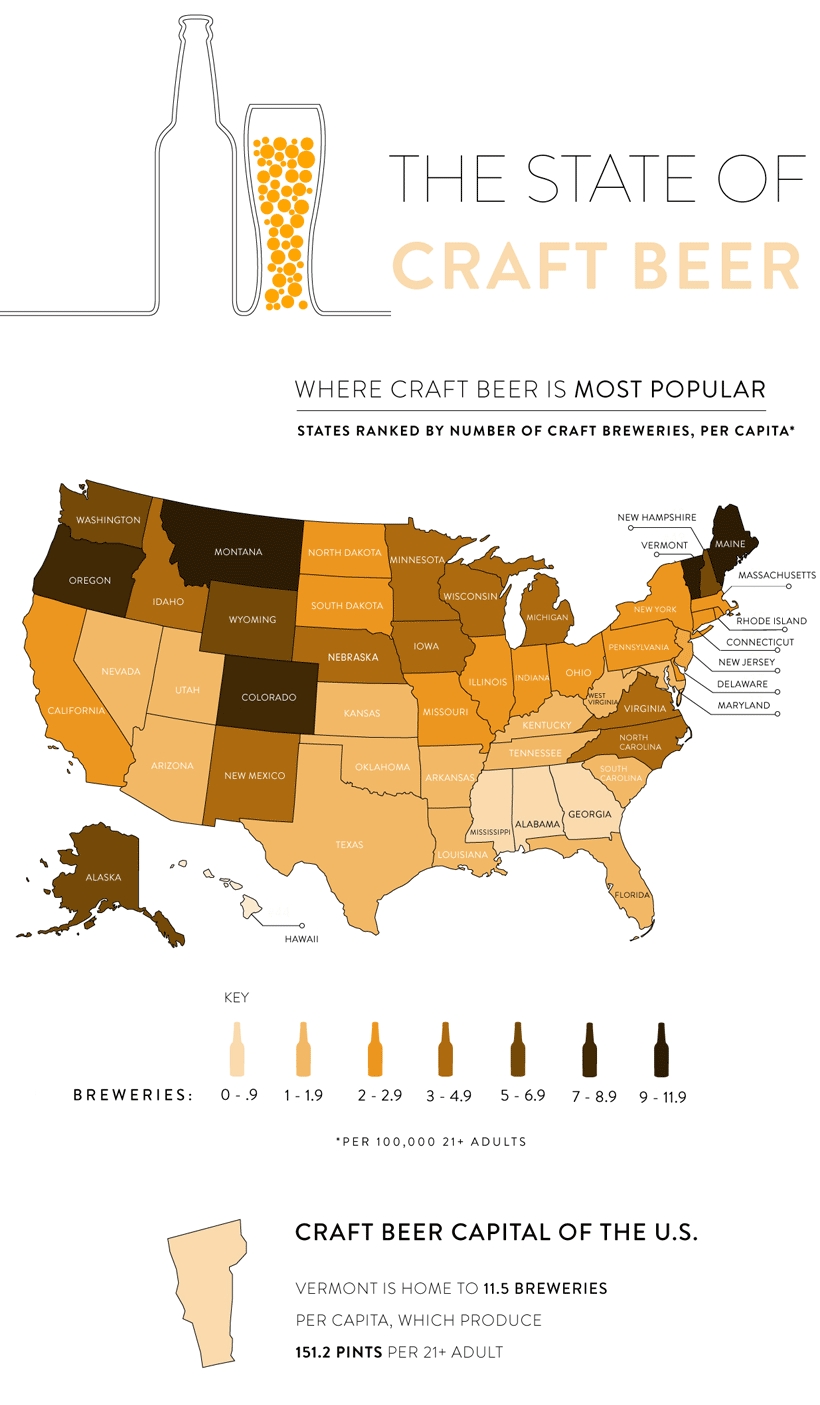
The data for this visualization comes from The Brewers Association—an American trade group of over 7,200 craft brewers, suppliers, and distributors, as well as the Alcohol and Tobacco Tax and Trade Bureau.
According to the data, Vermont has emerged as the craft beer capital of the U.S. with 11.5 breweries per 100,000 people. That’s equal to 151 pints of beer produced per drinking-age adult. Following closely behind are Montana and Maine, each with 9.6 breweries per capita.
You’ll notice that in Southern states such as Alabama, Georgia, and Mississippi, that there are only 0-0.9 breweries per capita. This is actually because of tighter liquor laws—for example, only 10 years ago, it was illegal to sell specialty beer in South Carolina that contained more alcohol content than a typical Budweiser.
Becoming a Brewery Nation
In 2008, there were only 1,574 breweries across the United States.
However, as you can see in the below data from the Brewers Association, the total amount of craft breweries, microbreweries, and brewpubs has climbed to 7,346 in just a decade.
| 2014 | 2015 | 2016 | 2017 | 2018 | Change ('17-'18) | |
|---|---|---|---|---|---|---|
| Regional Craft | 135 | 178 | 186 | 202 | 230 | 13.9% |
| Microbreweries | 2,076 | 2,626 | 3,251 | 3,933 | 4,522 | 15% |
| Brewpubs | 1,603 | 1,824 | 2,102 | 2,355 | 2,594 | 10.1% |
| Total Craft | 3,814 | 4,628 | 5,539 | 6,490 | 7,346 | 13.2% |
| Large/Non-craft | 46 | 44 | 67 | 106 | 104 | 1.9% |
| Total U.S. | 3,869 | 4,672 | 5,606 | 6,596 | 7,450 | 12.9% |
Of the three categories of craft beer, microbreweries have contributed the most to recent production growth. Last year, they accounted for 80% of this growth, up from 60% in 2017.
The term microbrewery refers to the maximum amount of beer the brewery can produce. For microbreweries, that number is 15,000 barrels (460,000 U.S. gallons) of beer per year. They also have to sell 25% or more of their beer on site, which is why we are witnessing a surge in breweries that double up as a restaurant or bar.
Comparing this data to figures on larger breweries available from the Breweries Association, it is clear that it is the larger, more established breweries that are feeling the heat. While their growth slows, more small breweries open, and sales are further cannibalized.
The Economic Impact of the Craft Beer Market
When it comes to pure dollars, C+R Research notes that Colorado comes in at #1 with an economic impact of $764 per person. Vermont is at the #2 spot with an economic impact of $667 per person, despite having a higher concentration of breweries per capita.
How do the rest of the states compare?
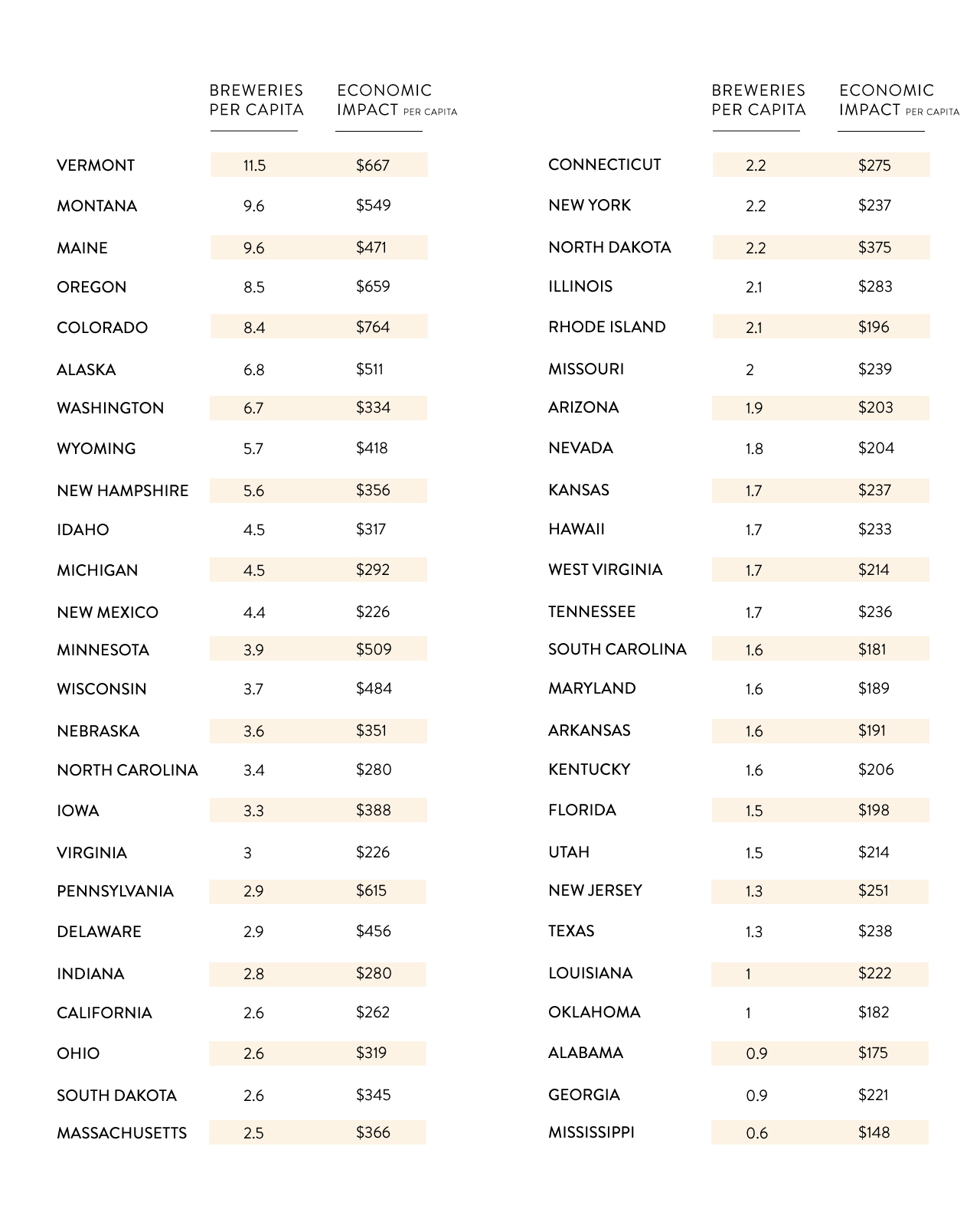
The global craft beer market is expected to reach $502.9 billion by 2025—while the craft brewing industry contributed $76.2 billion to the U.S. economy in 2017, including more than 500,000 jobs.
Will Craft Remain a Growth Category?
While many argue that craft beer is approaching its peak, the data is promising. Experimentation with new processes and ingredients will continue to drive the market forward.
Craft brewers all over the world are tapping into the novelty factor by exploring weird and wonderful innovations, like deer antler-infused beer and take-home brewing kits.
While the overall beer market lagged in sales by 0.8% last year, the craft brew category grew by 3.9% using the same measure. Further, craft still only makes up 13.2% in total beer volume in the U.S., meaning there is still plenty of market share to gain.
Markets
The European Stock Market: Attractive Valuations Offer Opportunities
On average, the European stock market has valuations that are nearly 50% lower than U.S. valuations. But how can you access the market?

European Stock Market: Attractive Valuations Offer Opportunities
Europe is known for some established brands, from L’Oréal to Louis Vuitton. However, the European stock market offers additional opportunities that may be lesser known.
The above infographic, sponsored by STOXX, outlines why investors may want to consider European stocks.
Attractive Valuations
Compared to most North American and Asian markets, European stocks offer lower or comparable valuations.
| Index | Price-to-Earnings Ratio | Price-to-Book Ratio |
|---|---|---|
| EURO STOXX 50 | 14.9 | 2.2 |
| STOXX Europe 600 | 14.4 | 2 |
| U.S. | 25.9 | 4.7 |
| Canada | 16.1 | 1.8 |
| Japan | 15.4 | 1.6 |
| Asia Pacific ex. China | 17.1 | 1.8 |
Data as of February 29, 2024. See graphic for full index names. Ratios based on trailing 12 month financials. The price to earnings ratio excludes companies with negative earnings.
On average, European valuations are nearly 50% lower than U.S. valuations, potentially offering an affordable entry point for investors.
Research also shows that lower price ratios have historically led to higher long-term returns.
Market Movements Not Closely Connected
Over the last decade, the European stock market had low-to-moderate correlation with North American and Asian equities.
The below chart shows correlations from February 2014 to February 2024. A value closer to zero indicates low correlation, while a value of one would indicate that two regions are moving in perfect unison.
| EURO STOXX 50 | STOXX EUROPE 600 | U.S. | Canada | Japan | Asia Pacific ex. China |
|
|---|---|---|---|---|---|---|
| EURO STOXX 50 | 1.00 | 0.97 | 0.55 | 0.67 | 0.24 | 0.43 |
| STOXX EUROPE 600 | 1.00 | 0.56 | 0.71 | 0.28 | 0.48 | |
| U.S. | 1.00 | 0.73 | 0.12 | 0.25 | ||
| Canada | 1.00 | 0.22 | 0.40 | |||
| Japan | 1.00 | 0.88 | ||||
| Asia Pacific ex. China | 1.00 |
Data is based on daily USD returns.
European equities had relatively independent market movements from North American and Asian markets. One contributing factor could be the differing sector weights in each market. For instance, technology makes up a quarter of the U.S. market, but health care and industrials dominate the broader European market.
Ultimately, European equities can enhance portfolio diversification and have the potential to mitigate risk for investors.
Tracking the Market
For investors interested in European equities, STOXX offers a variety of flagship indices:
| Index | Description | Market Cap |
|---|---|---|
| STOXX Europe 600 | Pan-regional, broad market | €10.5T |
| STOXX Developed Europe | Pan-regional, broad-market | €9.9T |
| STOXX Europe 600 ESG-X | Pan-regional, broad market, sustainability focus | €9.7T |
| STOXX Europe 50 | Pan-regional, blue-chip | €5.1T |
| EURO STOXX 50 | Eurozone, blue-chip | €3.5T |
Data is as of February 29, 2024. Market cap is free float, which represents the shares that are readily available for public trading on stock exchanges.
The EURO STOXX 50 tracks the Eurozone’s biggest and most traded companies. It also underlies one of the world’s largest ranges of ETFs and mutual funds. As of November 2023, there were €27.3 billion in ETFs and €23.5B in mutual fund assets under management tracking the index.
“For the past 25 years, the EURO STOXX 50 has served as an accurate, reliable and tradable representation of the Eurozone equity market.”
— Axel Lomholt, General Manager at STOXX
Partnering with STOXX to Track the European Stock Market
Are you interested in European equities? STOXX can be a valuable partner:
- Comprehensive, liquid and investable ecosystem
- European heritage, global reach
- Highly sophisticated customization capabilities
- Open architecture approach to using data
- Close partnerships with clients
- Part of ISS STOXX and Deutsche Börse Group
With a full suite of indices, STOXX can help you benchmark against the European stock market.

Learn how STOXX’s European indices offer liquid and effective market access.

-

 Economy2 days ago
Economy2 days agoEconomic Growth Forecasts for G7 and BRICS Countries in 2024
The IMF has released its economic growth forecasts for 2024. How do the G7 and BRICS countries compare?
-

 Markets1 week ago
Markets1 week agoU.S. Debt Interest Payments Reach $1 Trillion
U.S. debt interest payments have surged past the $1 trillion dollar mark, amid high interest rates and an ever-expanding debt burden.
-

 United States2 weeks ago
United States2 weeks agoRanked: The Largest U.S. Corporations by Number of Employees
We visualized the top U.S. companies by employees, revealing the massive scale of retailers like Walmart, Target, and Home Depot.
-

 Markets2 weeks ago
Markets2 weeks agoThe Top 10 States by Real GDP Growth in 2023
This graphic shows the states with the highest real GDP growth rate in 2023, largely propelled by the oil and gas boom.
-

 Markets2 weeks ago
Markets2 weeks agoRanked: The World’s Top Flight Routes, by Revenue
In this graphic, we show the highest earning flight routes globally as air travel continued to rebound in 2023.
-

 Markets3 weeks ago
Markets3 weeks agoRanked: The Most Valuable Housing Markets in America
The U.S. residential real estate market is worth a staggering $47.5 trillion. Here are the most valuable housing markets in the country.
-

 Debt1 week ago
Debt1 week agoHow Debt-to-GDP Ratios Have Changed Since 2000
-

 Markets2 weeks ago
Markets2 weeks agoRanked: The World’s Top Flight Routes, by Revenue
-

 Countries2 weeks ago
Countries2 weeks agoPopulation Projections: The World’s 6 Largest Countries in 2075
-

 Markets2 weeks ago
Markets2 weeks agoThe Top 10 States by Real GDP Growth in 2023
-

 Demographics2 weeks ago
Demographics2 weeks agoThe Smallest Gender Wage Gaps in OECD Countries
-

 United States2 weeks ago
United States2 weeks agoWhere U.S. Inflation Hit the Hardest in March 2024
-

 Green2 weeks ago
Green2 weeks agoTop Countries By Forest Growth Since 2001
-

 United States2 weeks ago
United States2 weeks agoRanked: The Largest U.S. Corporations by Number of Employees

